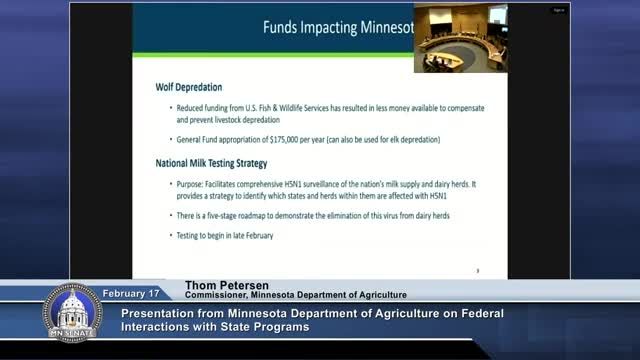Minnesota to begin mandatory milk testing next week as H5N1 spreads; officials say testing helps isolate outbreaks
February 17, 2025 | 2025 Legislature MN, Minnesota
This article was created by AI summarizing key points discussed. AI makes mistakes, so for full details and context, please refer to the video of the full meeting. Please report any errors so we can fix them. Report an error »

Commissioner Tom Peterson told the Senate committee that Minnesota will begin mandatory milk testing for H5N1 the Monday after the Feb. 17 hearing and that the state will initially front costs and seek federal reimbursement. "We're gonna be starting that on, on Monday, a week from today," Peterson said. He said the state had difficulty obtaining a timely cooperative agreement with USDA but expected reimbursement and planned to advance funds from the emergency account as needed.
Why it matters: Officials said early detection through farm-level testing can identify infected herds faster than testing only at processing plants, allowing case managers to work with producers to isolate cases, implement biosecurity and preserve pasteurized milk for sale. Peterson described Colorado’s experience, where widespread testing helped identify infections across dairy herds and allowed the state to contain and clear the virus within weeks.
Testing details and rationale: Peterson said the program will add an H5N1 test to the routine dairy samples already collected when milk is picked up, but samples will be tied to the originating farm so state officials can trace infections to specific herds. "Instead of just like bacteria and stuff they'll be also adding this test to that," he said, noting there is no direct testing cost to farmers and pasteurized milk remains safe for consumption. He and Michelle Medina emphasized the testing’s role in protecting poultry, calves and farm workers by identifying infections early.
Scope, lab capacity and staffing: Michelle Medina and Peterson raised concerns about laboratory capacity at the University of Minnesota veterinary diagnostic lab and other national labs, and about recent USDA field staff layoffs reducing in‑state lab and field capacity. Peterson also highlighted Minnesota’s larger dairy herd size (about 1,700 farms) compared with Colorado’s roughly 100, saying the consequences of wide spread infection in Minnesota would be much larger.
Public health coordination: Peterson said the Minnesota Department of Health offers testing to farm workers when an animal case is identified and provides PPE supplies (goggles, masks, gloves) through stockpiles; he noted goggles are important because conjunctivitis has been observed in some human exposures.
Ending: Committee members asked whether the state would be able to manage testing and follow-up if federal agencies are reduced; Peterson replied that state plans rely on close daily coordination with the Department of Health and that response capacity will be adjusted to available staff and resources.
Why it matters: Officials said early detection through farm-level testing can identify infected herds faster than testing only at processing plants, allowing case managers to work with producers to isolate cases, implement biosecurity and preserve pasteurized milk for sale. Peterson described Colorado’s experience, where widespread testing helped identify infections across dairy herds and allowed the state to contain and clear the virus within weeks.
Testing details and rationale: Peterson said the program will add an H5N1 test to the routine dairy samples already collected when milk is picked up, but samples will be tied to the originating farm so state officials can trace infections to specific herds. "Instead of just like bacteria and stuff they'll be also adding this test to that," he said, noting there is no direct testing cost to farmers and pasteurized milk remains safe for consumption. He and Michelle Medina emphasized the testing’s role in protecting poultry, calves and farm workers by identifying infections early.
Scope, lab capacity and staffing: Michelle Medina and Peterson raised concerns about laboratory capacity at the University of Minnesota veterinary diagnostic lab and other national labs, and about recent USDA field staff layoffs reducing in‑state lab and field capacity. Peterson also highlighted Minnesota’s larger dairy herd size (about 1,700 farms) compared with Colorado’s roughly 100, saying the consequences of wide spread infection in Minnesota would be much larger.
Public health coordination: Peterson said the Minnesota Department of Health offers testing to farm workers when an animal case is identified and provides PPE supplies (goggles, masks, gloves) through stockpiles; he noted goggles are important because conjunctivitis has been observed in some human exposures.
Ending: Committee members asked whether the state would be able to manage testing and follow-up if federal agencies are reduced; Peterson replied that state plans rely on close daily coordination with the Department of Health and that response capacity will be adjusted to available staff and resources.
View full meeting
This article is based on a recent meeting—watch the full video and explore the complete transcript for deeper insights into the discussion.
View full meeting
